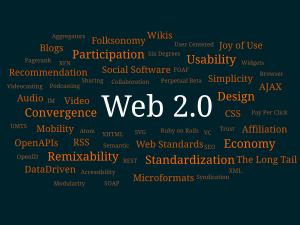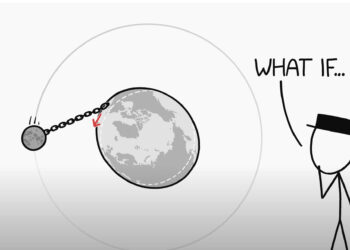
(Editor’s Note: For our final summer rerun, I wanted to take a look at social media and scientific research, to get a sense of whether we’ve seen much progress over the last few years. I’ve selected a piece I wrote in early 2010 that offered a likely explanation for the low level of researcher uptake, despite tremendous amounts of hype and offerings. It was particularly interesting to see how many of the links were no longer valid (I’ve updated them where I could), and how so many of the leaders in the field have either changed hands (FriendFeed, ScienceBlogs) or become virtual ghost towns (The Nature Network). This level of turnover and the impermanency speaks to a weakness of social media tools for the research world, where there’s great value placed on the archived, always-available, version of record of any communication. The problem described in the article, that so many approaches come from the world of research communication, rather than from the world of actually performing research, continues to confound. Using social media approaches to do research, rather than to talk about research remains an elusive goal.)
Science Online 2010, the annual meeting for cutting edge users of Web 2.0 technologies in science, was held last month. It filled the science blogosphere with coverage and allowed far-flung colleagues to meet in person. Bora Zivkovic, one of the organizers, has written a summary of the meeting, and his perception is that one of the overarching themes was examining media and journalism. But what’s perhaps more telling is what wasn’t a major theme of the conference, as pointed out by attendee Deepak Singh (link now defunct):
There are far too many sessions on journalism and policy, and far too little on doing science . . .
That may explain why so many of the high-profile attempts at adapting Web 2.0 technologies for scientists have failed to catch on, why we haven’t yet come upon the “killer app” that integrates social media into the mainstream of science. Nearly all of the more visible attempts so far have focused on talking about science, rather than tools for actually doing science.
Tools for communication are the low-hanging fruit, the obvious things to build based on Web 2.0 ventures that have worked in other areas, but so far they’ve failed to capture the interest of most scientists. Tools for doing science are much harder to envision and build. But these sorts of tools are much more likely to see uptake and use by the community, simply because scientists are more interested in doing science than they are in talking about science.
Discovery, doing research, gathering and interpreting results, that’s the very nature of being a scientist. There are people whose main focus is talking about science, but we have different names for them — teachers, journalists, editors, and publishers. Talking about science, communicating experimental results, teaching scientific concepts, and reaching out to educate non-scientists are incredibly valuable practices. Communication is an important part of being a scientist. It is not, however, the top priority for most. Nobel Prizes are given for achievements, not for writing entertaining blog entries or clever tweets. Being a good teacher is appreciated, but not as important to a career as uncovering groundbreaking results and securing funding.
Even without new online technologies, scientists already spend a substantial portion of their time communicating. They share results with peers, plan future experiments with collaborators, give talks, write papers, teach, etc. New social media endeavors ask scientists to devote even more time to communication, but it’s unclear where participants are supposed to find that time. Every second spent blogging, chatting on FriendFeed, or leaving comments on a PLoS paper is a second taken away from other activities. Those other activities have direct rewards towards advancement. It’s hard to justify dropping them for activities backed by vague promises that “you will be one of the early adopters and will be recognized and respected for this in the future.” That’s a tough gamble for most to take, and scientists are unlikely to risk current status for a leg up in the event that sweeping societal changes occur in how we fund, employ, and judge scientific achievement.
Self-serving predictions like this about the future are a dime a dozen. Remember that social media shares a lot in common with pyramid schemes. Pyramid schemes and social networks work better with more participants. If you’re involved in a pyramid scheme or a social network, it’s in your best interest to recruit others to join in. So there’s a nearly constant barrage of exhortations to participate, including unrealistic promises of future rewards. Are scientists in the future really going to be given tenure and funding for leaving good comments on the results of others, rather than discovering their own results?
Scientists are no different than other humans. Most people don’t blog. It’s not something they’re interested in doing. Blogging tends to attract those with a strong interest in communication, writing, and teaching, along with activists who are championing a personal cause (that’s why the online science world is dominated by discussions of causes like open access, open science, creationism vs. evolution, and climate change). What you see online reflects this small portion of scientists and may not be all that relevant to the greater community as a whole.
ScienceBlogs has around 80 regular bloggers. The Nature Network has around 40 blogs that have been updated in the last month (this figure seems to have dropped by 20% since I last checked). David Bradley lists 600-plus “science type” users of Twitter. Even if these numbers are just the tip of the iceberg, and there are 1,000 times that number of scientists involved, you’re still talking about a very small percentage of the tens of millions of working scientists in the world. Science blogging is a tremendously insular world, and frequently an inwardly-gazing one. It’s often noted that the most common topic covered by science blogs is science blogging.
Tools like blogging can be effective and useful, but they’re for talking about science, and that’s very different from tools built for actually doing science. The success and high visibility of things like Facebook, Twitter, and blogs has driven much of the development of Web 2.0 tools for scientists. These things worked in other arenas, why not here? It’s low-hanging fruit though, trying to shoehorn pre-conceived ideas into different communities rather than coming up with more ambitious new ideas developed directly for that community.
In the age of the sequenced genome and systems biology, scientists are more and more often dealing with enormous data sets. Experiments require collaboration on a scale never seen before. Though they’re just in their infancy, tools to store, process, and interact with data are more likely to draw scientific users than blogging platforms. These are much harder to conceive and develop than yet another “Facebook for scientists.”
Databases like HapMap and Chemspider are increasingly useful. Community-built resources like WormBase/WormBook/WormAtlas are great examples of projects that have drawn researchers into donating their valuable time and efforts. All of these take principles of Web 2.0 — from crowdsourcing to remixing of previously available data — to build new tools that create efficiencies. Information is aggregated and can be processed in one step, rather than having to gather and try to tie together data from disparate sources. It’s still the early days for these types of resources, and likely the really useful groundbreaking ones are still ahead of us.
Science publishers are deeply interested in new web technologies and have been behind many of the higher-profile attempts at social networking for scientists. Perhaps we need to change our thinking on the subject, and divide our efforts into separate paths:
- Communication: Web 2.0 technologies provide superb ways to help us do our jobs better, and publishers should be employing them regularly. Editors and writers should blog and tweet to spread the word about the useful results we’re publishing. If our job is to facilitate the communication of knowledge discovered by our authors, we need to go beyond the published paper. While we’ll be joined in this effort by a small band of scientist-communicators, it’s probably unlikely that we’ll see much participation beyond that. Investing in platforms to provide these tools for something most readers don’t want to do is not an efficient use of our funds or time.
- Tools for Work: Every journal is looking for a leg up on the competition, looking for offerings that make them more attractive than other journals. Instead of offering yet another suite of communication tools likely to be ignored, we need to instead focus on the priorities and needs of our readers. Can we create new resources that support communities or that aggregate information in valuable ways? Can we open up our journals and let others tinker with our content and data to create something new (think along the lines of the Guardian’s open API)? Can we create new efficiencies for scientists, ways to make them more productive rather than tools that ask them to take time away from their research? Can we develop tools for doing science, rather than tools for talking about science?
Creating new resources and experimenting with new technologies is often an expensive and time-consuming endeavor. We need to stop wasting our efforts copycatting ideas that may work for other situations and instead focus on the communities we serve. Communication tools can be put to great use, but we shouldn’t settle for them just because they’re obvious and easy to build. Finding ways to help scientists spend more time at the bench and to get more out of that time will succeed where the current crop of peripheral distracting tools have failed.
Discussion
12 Thoughts on "Stick to Your Ribs: Science and Web 2.0: Talking About Science vs. Doing Science"
This is very interesting re-visit of a post from ~3yrs ago. While I’m a big believer that scientists should know how to effectively communicate their work, I agree that their main focus should be their research and that where we should really make a use of the Web 2.0 is by providing better tools for researchers to do their work more efficiently. That’s why in Scizzle (which is still in its infancy) our motto is “Don’t Search. Research.” as our ultimate goal is to provide scientists with a way to find everything that matters to them in science in one place and easily organize, share and collaborate. So they can spend less time searching and more time researching.
However, search and collaboration play a relatively small role in research, mostly in project formulation. Once researchers decides what they want to do they are typically on their own, alone. (This is why I dislike using the term “discovery” when referring to search, as scientific discovery is something quite different.)
Does Scizzle have a website? It sounds a bit Utopian as there is no such thing as everything that matters. The concept is too vague to be meaningful.
I think collaboration always was, and remains something of a red herring for these attempts at social networks for scientists. Most offer promises of easy ways to find collaborators, but in my experience, that’s not something that’s desired. There is a cost to collaborating, at least once you get out of the realm of theoretical fields, or computational fields where all you have to do to collaborate is send someone a link to a dataset or algorithm.
For the wet bench scientist, collaborating means investing precious funding, valuable resources and even more precious time and effort. Given the scarcity of the the above, and the enormous time demands made on academic scientists, this is not a decision that is entered into lightly. You don’t just collaborate with every stranger you meet on the internet, rather the choice is carefully made after extensive research. I remember being told by a young professor that she puts more care into choosing collaborators than she does who she lets into her bed, which puts things into perspective.
Search may play a small role in research in your eyes, but if one doesn’t “research”‘ before the actual experiments properly, or in other words, search ineffectively, it can lead for lots of wasted time in the actual research, and I’m talking about “wet bench” research, as for example, you may end up repeating something that was already done, missed a better new technique and so on.
Unfortunately, for things to be meaningful you need to read the whole sentence. The point of Scizzle (www.myscizzle.com) is that you can find what matters to YOU and for your research, not what matters in general, and as such, this is a very subjective thing.
I noted that search plays a role in project formulation, which is what you are referring to. For example proposals typically have to demonstrate knowledge of what has been done. I am in the search algorithm business and have done a lot of research on the uses of search.
As for what matters, I did read rhe full sentence and included it in my assessment. Your claim to find everything that matters to a given researcher at a given time is either meaningless of false. Such a query cannot be formulated. I suggest you adjust your message to say what Scizzle actually does. I would be happy to help you.
“Everything” is indeed a bit broad for a service that is apparently limited to searching PubMed. The world of science does not begin and end with PubMed. And it’s not clear why using a third party to set up a saved regular search is superior to doing so directly (and perhaps using something more broad like Google Scholar or Scirus). There’s already a rich history of search engines and tools for scientists that have failed to gain much traction, not sure I see anything here that is likely to make a difference.
Search may play a small role in research in your eyes, but if one doesn’t “research”‘ before the actual experiments properly, or in other words, search ineffectively, it can lead for lots of wasted time in the actual research, and I’m talking about “wet bench” research, as for example, you may end up repeating something that was already done, missed a better new technique and so on.
Unfortunately, for things to be meaningful the whole sentence should be read. The point of Scizzle (www.myscizzle.com) is that you can find what matters to YOU and for your research, not what matters in general, and as such, this is a very subjective thing.
This may be a niggling point but Web 2.0 refers to much more than just social media. It refers to executable web pages (versus static web pages). These play a major role in social media, logging comments like this one for example, but they have many other uses. How these other uses may have changed how science is done is largely unknown I think.
For example my NWS local weather forecast page has a window with a topo map and a moveable cross hair. Moving the cross hair I can generate forecasts for different places. This is Web 2.0 in action. Thus I can study how the forecasting model handles mountains.
On the search side Google Scholar’s related items button executes a complex full text search algorithm. This is a powerful Web 2.0 tool for researchers and many large publishers have similar tools on their websites. Surely this has changed the way researchers understand what is going on in their field, but so far as I know no one is studying this. There may be an altmetric in here somewhere, which is another point about Web 2.0. It makes behavior visible.
Well, it is something of an archaic term at this point (dating to 1999), and somewhat passé, and to be fair, the post does date back a ways, to the height of the science blogging craze. Technologies that fall under this definition have continued to evolve, though Wikipedia lists as examples the sorts of things referred to in the post:
https://en.wikipedia.org/wiki/Web_2.0
Examples of Web 2.0 include social networking sites, blogs, wikis, folksonomies, video sharing sites, hosted services, web applications, and mashups.
Indeed, back when the hype was starting to build I was tasked by DOE OSTI to do a study to see if Web 2.0 was even real, which I reported it certainly was. They implemented a number of applications including commenting on reports and a more-like-this report search feature. The fun days of revolution. But the core technical concept was being able to execute a program rather than merely hypertext reading and linking. Of course many people think of it in terms of specific widespread examples, especially social stuff, some of which have generated reform movements of their own.
As always, we run into the conflict between the formal definition of a term and the popular use of that term (see “open access”, particularly “gold” and “green” for further examples).


